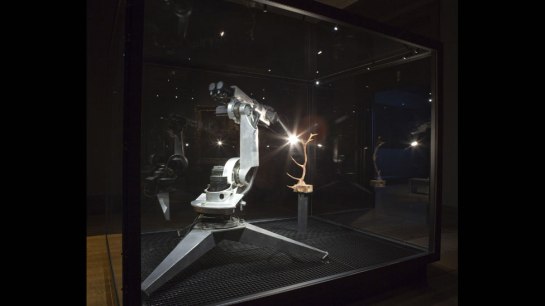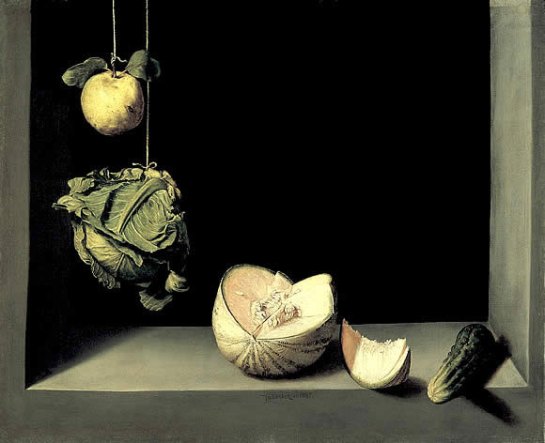Early Morning, Station Platform
In the station car park two men lean on the bonnet of a white van, wreathed in the noise of important radio communication. Their role is printed in fluorescent yellow across their flak jackets: ‘Environmental Enforcement Officer’. The loud radios are on their shoulders, their utility belts bulge with objects full of function, the belt cuts into the waist of one of them to create a perfect wave form. He has a no 1 crop and a swallow tattoo on the back of his neck, his companion is a shorter younger wannabe version, perhaps he is saving up for the tattoo and the stomach. Their van also has ‘Environmental Enforcement’ written on it, the lights are on and the engine is running.
It takes a while to work out what these two are doing, what aspects of the environment they are enforcing, shouting at trees to grow maybe, telling raindrops which way to fall (down?). Do Urk and Splurk lounging on their bonnet have advanced environmental enforcement accreditation I wonder; making seeds grow in Fibonacci spirals for example, or enforcing Newton’s Laws of Motion perhaps? They stop one attractive young woman after another, eventually (the train is late) I realise; they are car park attendants checking tickets.
Stylish, Functional and Bulletproof
The bulletproof flak jacket style, usually modelled by TV war reporters and inner city policemen, is obviously necessary for this ordinary area of the Southeastern Railways empire. Particularly at this time of the morning, full of self important businessmen and feral schoolchildren travelling to the most selective schools in the country clutching their Latin homework. You could accuse the visual language that clothes Urk and Splurk of turning the volume up to eleven, but it is really part of a long tradition. A tradition that, in a convoluted manner, reminds me of Rubens, Rembrandt and Veronese, Alexander the Great obviously and a loathsome pop song that includes the words ‘You don’t have to turn on the red light’.
The Functions of Portraiture
In art, one of the functions of portraiture is to aggrandise, to mythologise the banal. The activities in the station car park took me back to a painting in the National Gallery, London: Thomas de Keyser’s ‘Portrait of Constantin Huygens and his (?) Clerk’.

Thomas de Keyser: ‘Portrait of Constantin Huygens and his (?) Clerk’. 1627, Oil on oak. 92 x 69 cm. National Gallery, London
An important man is sitting in a well-appointed room, he is not looking at us, he is receiving a letter. This is a Northern European painting, smallish and carefully painted, a cultural context which tells us to be aware of detail, composition and possible layers of iconographic meaning. From 1625 Huygens was secretary to the Stadtholder, or the chief executive of the province of The Hague, and the House of Orange. He is the self-consciously northern version of Baldasarre Castiglione’s the Courtier, as painted by Raphael.
 Where Does the Door Lead To?
Where Does the Door Lead To?
Where do we find clues for all this? There is a doorway revealed by the pulled back tapestry, why? A painted space within a space; always a clue. Is the tapestry relevant for example? According to the usual sources, it is St Francis of Assisi being presented to the Sultan (in essence, St Francis promoting peace through dialogue not war) it is rumpled, and dark in such a way that it doesn’t present us with another space to seductively slip into, it is a luxurious object. This makes sense, that was the sitters role, to source luxury objects for his employers, and as a diplomat to promote peace.

Thomas de Keyser: ‘Portrait of Constantin Huygens and his (?) Clerk’. 1627, Oil on oak. 92 x 69 cm. National Gallery, London. Detail: Doorway
But where does the door lead to? Through art (the tapestry) we go to where? Art is a significant part of diplomacy, as this painting shows us, the sitter understood that language well.
Rubens and Alexander the Great
One of Huygens first acts for the newly married Prince Frederick Hendrick, was to negotiate the purchase of Rubens’ ‘The Marriage of Alexander and Roxane’.

Rubens: ‘Modello for Marriage of Alexander and Roxane’, oil on panel, 40 x 30 cm
That painting had a specific, relevant message. Frederick’s wife, Amalia although an important dynastic bride, was not of suitable rank or pedigree for the House of Orange. Like Vasari for the Medicis, Huygens organised art and it’s setting, a visual language that emphasised the ancient ancestry of the House of Orange. Hence the subject of the Rubens painting, Alexander married Roxane, the daughter of a chieftain, in a strategic marriage although legend tells us that Roxana was ‘the only passion which he, the most temperate of men, was overcome by’ (Plutarch: Life of Alexander, 33:47). A marriage equally disapproved of; Roxane was not of the right blood, any child would not be pure Macedonian.
By the way, after his invasion of India, back in Babylon, Alexander made another strategic marriage, to a new Persian wife, Staterira, a daughter of King Darius. After Alexander’s death, Roxane had Staterira and her child murdered.
Veronese?
And the relationship to Veronese, and uniforms?

Paolo Veronese: ‘The Family of Darius before Alexander’, 1565-7. oil on canvas, 236 x 475 cm. National Gallery, London
Veronese’s Family of Darius before Alexander, a painting that turns on misidentification, the grandmother appealing for the lives of her family, but to the wrong man, and one of her grandchildren in the painting is of course: Staterira.
The Police?
I don’t need to mention that awful song again do I? ‘Sell your body to the night’, yuk.
Rembrandt?
Well you can understand Huygen’s knowledge of art when you discover that he was one of the first of Rembrandts patrons and he recommended him for his first significant commission.

Rembrandt: ‘Portrait of Maurits Huygens’, 1632, oil on oak. 31 x 25 cm. Kunsthalle, Hamburg.
This portrait of Huygen’s brother leads some critics to believe that the other figure in this painting is not his clerk, but his brother, also employed by the Stadtholder, what do you think?
Travel and Visual Language
Or the painting?

Thomas de Keyser: ‘Portrait of Constantin Huygens and his (?) Clerk’. 1627, Oil on oak. 92 x 69 cm. National Gallery, London. Detail: Painting Within a Painting
Above the mantelpiece is a marine painting in the style of Jan Porcellis, whom Huygens admired, and it tells us about travel of course, he had spent time in the English court, and that is another pointer to this form of composition. Paintings within paintings, painted spaces within painted spaces, are always important signposts.
Visual languages have meaning too, often to do with status, or the wish of the portrayed to achieve a higher status (think of the flak jackets). The same is happening here. As second-generation immigrants from the Catholic Southern Netherlands, the Huygens needed noble status, and how do they do that? Promotional image making: knowledge; wealth; success, all evident here, but look at the basic forms of the composition itself. In his time in the English court, Huygens would have seen the grand but less formal paintings of the nobility and royalty in the Stuart court and the collection of the Earl of Arundel in particular. Notice the simple point that he is sitting whilst others stand; a royal prerogative. This painting appropriates the language of nobility and power, marries it with Vanitas themes (to avoid accusations of arrogance) Again this part of a Northern tradition,

Jan van Eyck: ‘The Arnolfini Portrait’, 1434, oil on panel. National Gallery, London
it was what van Eyck was doing with the Arnolfini Portrait of two nouveau riche aspirant Italian cloth merchants some two hundred years earlier
Vanitas
Those Vanitas themes are most prominent on the table, the lute referring to his interest in music, as well as books and architectural drawings (with the Dutch architect Pieter Post, he designed his own house), luxury goods of little use in the long, long afterlife. The globes, those two huge round orbs behind the table, refer his interest in geography and astronomy (he designed telescopes and other scientific instruments). Truly a Renaissance man and keen to tell us so.

Thomas de Keyser: ‘Portrait of Constantin Huygens and his (?) Clerk’. 1627, Oil on oak. 92 x 69 cm. National Gallery, London
By Their Boots Shall Ye Know Them
It’s all in the uniform of course, the clothing. Look at the sombre but expensively tailored clothing, the uniforms of these two. The clerk (if it is a clerk, not Constantin’s brother) wears shoes, he is an indoor clerk. Whereas Constantin wears splendid riding boots, almost theatrical in their bootness; a travelling man, in considerable style.
Notice also the hands and gloves, which make a complex centre of attention on the left and, via a gently curving line draw attention to his un-gloved hand lying on the architectural plan on the table. The gloves are fringed with Orange, either a discrete reference or a piece of specific uniform for those working for the House of Orange, its shows he is ‘hand in glove’ with his employer.
Return Journey, on the Platform
I watch two men in clothing that stands out somehow. It is too clean, the check shirts are buttoned too firmly, the clean jeans have an ironed crease, the black shoes are shiny. They are closely questioning a much younger man in grubby grey tracksuit bottoms and a T shirt with ‘Keep Calm’ etc printed on it. It is quickly apparent that they are plain clothes ticket inspectors, they wear their ‘plain clothes’ slightly theatrically, to make it clear that it is a costume relevant for their importance and occupation,
“I wouldn’t lie to you, you know. I’m going to Swanley to get the money to come back. I ain’t got no money and that’s straight up. But when I get there, Swanley I mean, then I’ll get the money to come back, know what I mean.”
The inspectors are puzzled by the rationale behind a journey to get the money to pay for the journey to get the money, perhaps they have not seen enough Pinter or similar. Do we feel as if we’re in a play? We are anyway; beneath the blue suburban skies my train arrives and takes me away.
















































